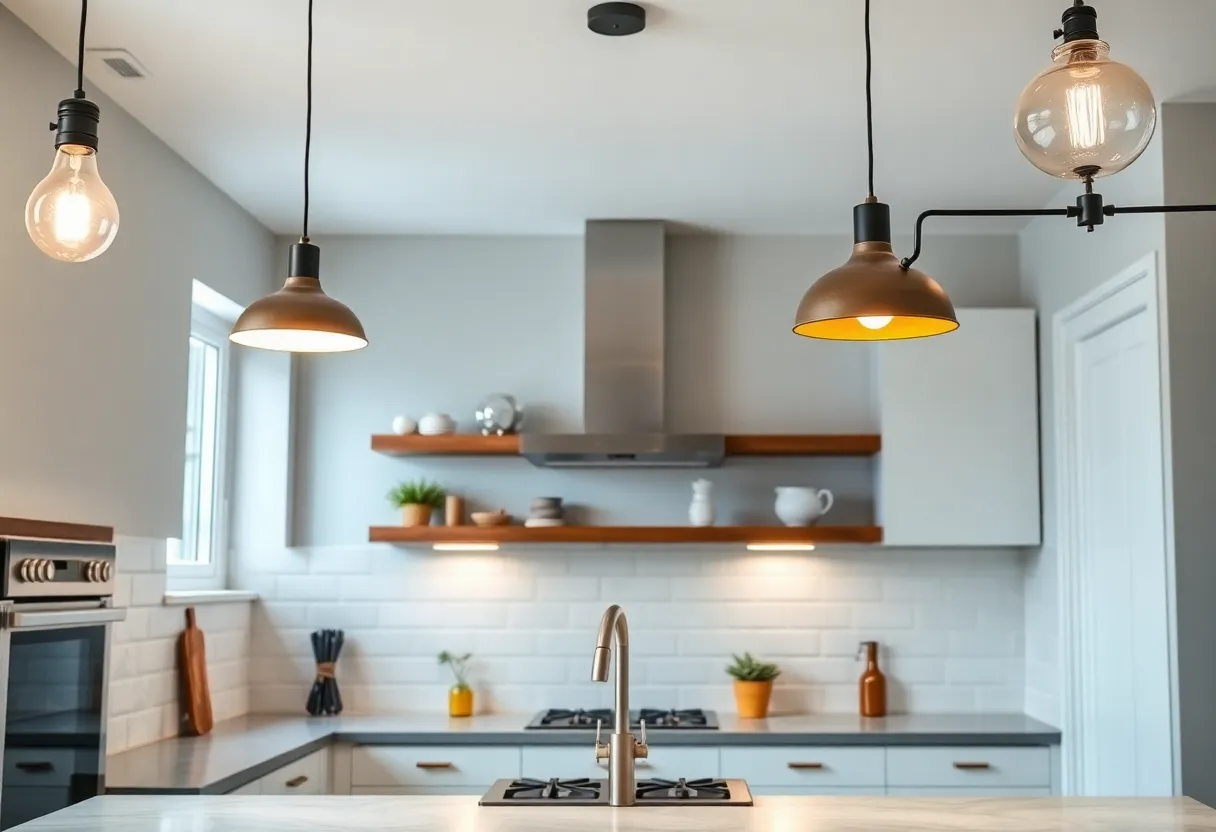Illuminating Ideas: Top Kitchen Lighting Trends of 2025
The kitchen is often referred to as the heart of the home, a gathering place for families and friends alike. As we approach 2025, the significance of kitchen lighting trends is more palpable than ever. Proper lighting not only enhances functionality but also elevates the ambiance and aesthetic of the space. In this article, we will explore the most pertinent kitchen lighting trends shaping the contemporary culinary environment.
1. Smart Lighting Solutions
Technology continues to make waves in every home aspect, and kitchen lighting is no exception. Smart lighting solutions are evolving rapidly. Homeowners can control their kitchen lights through voice commands or apps, adjusting brightness and color to suit different moods and activities.
Smart bulbs and fixtures are becoming increasingly popular. They allow for programmability and customization, enabling users to set specific lighting scenarios for cooking, dining, or entertaining. As connectivity improves, these systems are expected to become even more intuitive, adapting to the preferences and routines of individual users.
2. LED Efficiency and Versatility
LED lighting remains at the forefront of kitchen lighting trends. Known for their longevity and energy efficiency, LED fixtures are increasingly being integrated into kitchen designs. These lights offer a broad spectrum of colors and brightness levels, allowing homeowners to find the perfect illumination for their spaces.
Adapting to different kitchen styles, LED strip lights are gaining traction. They can be installed under cabinets, along shelves, or even under countertops. This versatility not only adds visual interest but also improves functional lighting without taking up physical space.
3. Layered Lighting Designs
Layering is a design technique making significant strides in 2025. A well-lit kitchen combines ambient, task, and accent lighting. Ambient lighting serves as the primary means of illumination, while task lighting focuses on specific work areas, such as over sinks and countertops. Accent lighting highlights architectural features or decorative elements within the kitchen.
Effective use of layered lighting can significantly elevate the overall design. It creates depth and dimension while addressing the functional needs of the kitchen. Homeowners are encouraged to consider varying light sources and intensities for optimal results.
3.1 Ambient Lighting
Common options include recessed lighting or ceiling fixtures. These lights provide overall illumination without overpowering the space. They are essential for creating a welcoming atmosphere.
3.2 Task Lighting
Task lighting is critical, especially in kitchen areas where precision is necessary. Pendant lights over islands or under-cabinet lights for countertops serve this purpose effectively. There is an increasing preference for adjustable fixtures that allow users to direct light where it is needed most.
3.3 Accent Lighting
Accent lighting can take the form of stylish pendant lights, under-shelf lighting, or showcasing art and decorative elements. This layer not only enhances the visual appeal but serves to highlight the homeowner’s personal style.
4. Sustainable and Eco-Friendly Options
As sustainability becomes a primary focus, eco-friendly lighting solutions are on the rise. More manufacturers are producing lights from recyclable materials or utilizing energy-efficient technologies.
Solar-powered lighting is gaining traction, especially in homes that prioritize green energy. These fixtures can be integrated into kitchens where natural light may be less abundant. Additionally, incorporating salvaged or upcycled light fixtures into kitchen designs reflects a commitment to sustainability.
5. Vintage and Retro Styles
While modern and sleek designs dominate the kitchen lighting landscape, there is a noticeable shift towards incorporating vintage and retro elements. Industrial-style fixtures, such as metal pendant lights and Edison bulbs, add character and charm to contemporary kitchens.
This trend bridges the gap between modern functionality and timeless design. Homeowners are curating spaces that reflect their personality while embracing styles from previous decades.
5.1 Unique Fixtures
Statement pieces are gaining popularity as kitchen lighting solutions. Unique designs such as oversized chandeliers, geometric pendants, or sculptural lamps can serve as focal points within the kitchen.
5.2 Warm Color Temperatures
The warmth of color temperatures is also trending. Lights with softer, warmer hues create a cozy atmosphere, making spaces feel inviting. This is particularly appealing for kitchens where gatherings occur.
6. Versatile Pendant Lighting
Pendant lighting continues to shine as a popular choice for both aesthetic appeal and functional utility. These fixtures can be hung at various heights, making them adaptable for different kitchen configurations.
Combining different pendant sizes and styles within a single space offers a dynamic visual element. Cohesion can be achieved by using similar materials or color palettes across various pendants.
7. Enhanced Natural Light
Natural light has long been celebrated in kitchen design. However, in 2025, the focus is on enhancing existing light rather than simply allowing it in. Homeowners are optimizing window treatments and illuminating areas with reflective surfaces to amplify natural light.
Translucent materials such as frosted glass or open shelving can enhance illumination while maintaining privacy. This approach not only addresses functional needs but enhances the kitchen’s overall design.
8. Customized LED Solutions
Personalization is key in modern kitchen lighting. Customized LED solutions are increasingly sought after. Tailor-made approaches allow homeowners to create unique lighting layouts that meet their specific needs.
For example, customizable color-changing LEDs can be integrated into cabinetry, providing flexibility for various occasions—from bright white for cooking to soft ambient colors for entertaining.
9. The Role of Dimmers
Dimmers are essential in optimizing kitchen lighting trends. They allow for control over brightness levels, catering to different activities and moods. Homeowners can seamlessly adjust lighting for bustling cooking sessions or intimate dinners.
The integration of smart dimmer switches further enhances versatility, enabling remote control and programmable settings for added convenience.
10. Integration with Home Automation Systems
As home automation systems gain popularity, the integration of kitchen lighting with overall smart home technology is on the rise. From syncing lights with security systems to scheduling illumination based on time of day, seamless connectivity improves convenience and safety.
Innovative systems are being developed to allow for intricate lighting controls and automation. This level of integration creates a cohesive home environment that prioritizes functionality and energy efficiency.
Conclusion
The kitchen lighting trends of 2025 reflect a balance between functionality, sustainability, and design aesthetics. Smart technology, layered lighting, eco-friendly options, and unique fixtures are just a few elements shaping contemporary kitchen environments. Homeowners are encouraged to approach kitchen lighting with creativity and individuality, considering the evolving landscape of design and technology.
As we look to the future, understanding these trends will empower homeowners to make informed decisions about their kitchen lighting, ultimately enhancing both the beauty and functionality of one of the most important spaces in their homes.
Author: STAFF HERE NOVI WRITER
The NOVI STAFF WRITER represents the experienced team at HERENovi.com, your go-to source for actionable local news and information in Novi, Oakland County, and beyond. Specializing in "news you can use," we cover essential topics like product reviews for personal and business needs, local business directories, politics, real estate trends, neighborhood insights, and state news affecting the area—with deep expertise drawn from years of dedicated reporting and strong community input, including local press releases and business updates. We deliver top reporting on high-value events such as Motor City Comic Con, Michigan State Fair, and Novi Home and Garden Show. Our coverage extends to key organizations like the Novi Chamber of Commerce and Novi Community Foundation, plus leading businesses in automotive, technology, and manufacturing that power the local economy such as Gentherm, Stoneridge, and Daifuku North America. As part of the broader HERE network, including HEREDetroitMI.com, HEREGrandRapids.com, HERENorthville.com, and HEREPlymouth.com, we provide comprehensive, credible insights into Michigan's dynamic landscape.







